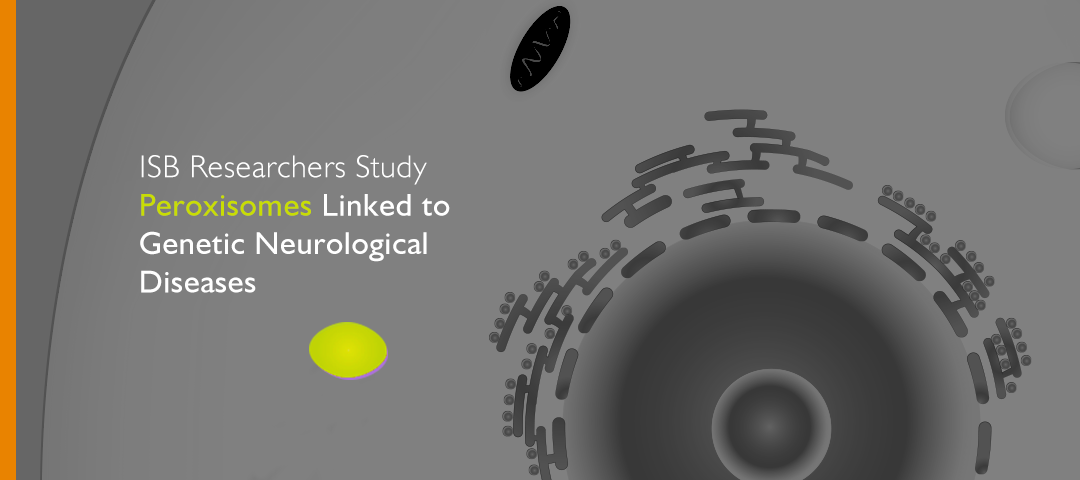Tiniest Malfunctions in a Cell Can Cause Devastating Diseases
 isbscience.org/news/2014/02/19/tiniest-malfunctions-in-a-cell-can-cause-devastating-diseases/
isbscience.org/news/2014/02/19/tiniest-malfunctions-in-a-cell-can-cause-devastating-diseases/
3 Bullets:
- ISB researchers are studying peroxisomes, which are cellular organelles that are linked to a rare syndrome that causes progressive organ complications and infant mortality.
- Peroxisomes have a role in metabolizing and breaking down cellular waste.
- Because peroxisomes easily change shape and function according to a cell’s needs, a systems approach is necessary to help decipher that complexity.
By Dr. Thurston Herricks
Dane Tolmie was a 19-month old boy who died of Zellweger syndrome on April 11, 2010. His parents announced “with heavy hearts and teary eyes” that he “passed quietly and peacefully in his hospital room at Seattle Children’s” and that while they all had a chance to hold him to say goodbye, nothing could have prepared them for such a loss – especially given the devastation that Zellweger syndrome wreaks.
Zellweger syndrome is a congenital disorder that has no cure and usually is terminal within an infant’s first years. It deteriorates the central nervous system, particularly the nerves in the brain, leading to a progressive loss of sight and hearing. It also causes facial deformities, seizures, liver and kidney issues, low muscle tone, the inability to eat – a cascade of complications too severe to overcome.
It is for the Tolmie family and others like them that researchers at Institute for Systems Biology study peroxisomes.
Peroxisomes are organelles within a cell that are responsible for a wide range of metabolic functions and exist in all eukaryotic cells. While peroxisomes can have a variety of roles in the cell, their two primary functions are the metabolism of fatty acids and the breaking down of toxic byproducts such as hydrogen peroxide. These types of reactions are critical for synthesizing cell components and therefore need to be isolated and well-regulated within the peroxisome organelle to protect the cell from oxidative damage. These and other functions of peroxisomes are vital to cells and the organs composed of those cells. Zellweger syndrome is just one example of peroxisome biogenesis disorders (PBDs). The incidence of PBDs was originally estimated to be about 1 in 50,000, but the recent identification of several adults with milder and slow-progressing neurological symptoms suggests a much higher incidence rate.
Dr. Jennifer Smith, a senior research scientist in Dr. John Aitchison’s lab at ISB, is an expert in peroxisomes and yeast biology. She and other researchers in the Aitchison Lab are investigating the dynamics of peroxisome formation in yeast by generating models that predict what genes yeast cells express in response to changes in their environment.
“Recent studies suggest that peroxisomes have important roles in various metabolic and neurodegenerative disorders that have yet to be fully understood,” said Smith, who co-authored, with Aitchison, a review of peroxisomes research in a Dec. 2013 issue of Nature Reviews Molecular Cell Biology. “We hope to use our tools as systems biologists to find out how genetic defects and other perturbations cause peroxisome abnormalities and then possibly engineer methods to counteract those defects.”
The reason yeast is a model organism for this research is that the genes that encode peroxisomes in humans are remarkably similar to those found in bakers yeast. Yeasts also have incredibly well-characterized proteomes and genomes making them genetically tractable and ethically favorable to model and investigate peroxisomal disorders. The methodologies to induce peroxisome formation in yeast are readily available, too.
Dr. Sam Danziger, a bioinformatics scientist in the Aitchison Lab, explained how ISB can generate models from existing datasets (read more from the Nucleic Acids Research publication): “We built a model of yeast behavior from more than a thousand yeast experiments and then focused on those parts of the model that are related to peroxisomes, which let us find additional genes that regulate peroxisomes at different stages of peroxisome proliferation.”
While this work has moved the field one step closer to understanding the factors that control peroxisomes, there remain a vast number of unknowns. Determining exactly how genetic defects in peroxisome genes eventually manifest as diseases has been difficult due to the inherent complexity and interconnectedness of the genes that regulate peroxisomes biogenesis. No individual gene by itself is completely responsible for the formation and function of peroxisomes. Instead, large groups of genes work in concert, interacting as a system to control peroxisome biogenesis and maintenance. The cross-disciplinary approach of systems biology is uniquely suited to investigate the complex factors that contribute to peroxisomal disorders.
“We hope to develop methodologies to prevent or lessen the effects of peroxisomal disorders, such as Zellweger syndrome, and maybe other diseases like Parkinson’s and Alzheimer’s,” Smith said.
About Dr. Thurston Herricks: Thurston is a research scientist in the Aitchison Lab at ISB. He is a member of the ISB Editorial Board.





